
Bahamian Provisioning Locations Menu: 1 2 3 4 5 Next>>
Golden Age of Piracy Provisioning - Bahamas Page 3
Bahamian History Related to Food, Continued
The Flying Gang Pirates and Their Downfall
Other than Madagascar, no location served the pirates as a provisioning station so well as the Bahamas following the cessation of hostilities during the War of Spanish Succession in April of 1713. As mentioned, the shallow drafts and convenient location of the islands, the desire of a large part of the population to be free of English control, the gradual degradation of the government by various corrupt governors, the use of the Bahamas as a base for privateers and the openness of the people to work with pirates all made this possible. Historian Manuel Schonhorn, modern editor of the General History of the Pyrates, explains that after the signing of the Treaty of Utrecht, the pirates "found a permanent base at New Providence in the Bahamas,
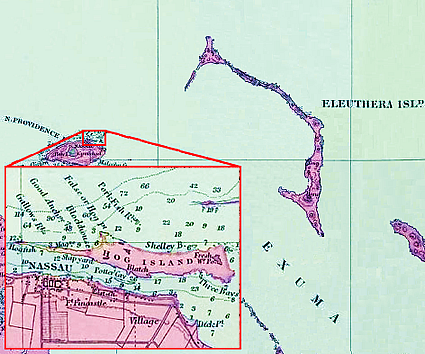
Cartographer: Edward Stanford
New Providence and Eleuthera with Inset showing Hog Island (1901)
which the influx of merchants, traders and doxies made a pirates’ haven; they made temporary and knowledgeable use of the many uninhabited islands, with their convenient harbours for careening and provisioning, which dotted the Caribbean and the deserted coasts of the Carolinas."1
For much of the decade before the Treaty o f Utrecht, people had warned the English government of the potential of the Bahamas to support pirates. This continued after peace was declared. In April of 1714, Bermudian Lieutenant Governor Henry Pulleine warned the Council of Trade and Planations that approximately 200 families lived in the Bahamas, most of them residing on Eleuthera, Harbor Island and New Providence, "who live without any face or form of Governmt. every man doing onely what's right in his own eyes. They have serv'd, of late, as a retreat for three setts of pyrates, who committed their depredations in open boats, with about five and twenty men in a boat."2 Pulleine said that the pirate activity had begun around September of 1713, and two of the pirate captains were John "Cockram, and Hornygood [Benjamin Hornigold], both of which, at present, are refug'd amongst those people."3 He warned that so long as the islands were not properly settled, they would continue to be "a nest for pyrates... [living] riotously and quickly spen[ding], what they as wickedly got."4

Pirate Benjamin Hornigold, From The General History of
The Pyrates, 2nd ed. (1725)
Hornigold was probably a privateer during the War of Spanish Succession. In the footnotes to the contemporary work The state of Jamaica, the author says, "Homygold and Fox... were the first that turn'd Pyrates in the West-Indies, after the Peace with France and Spain"5. It is not entirely clear from this who 'Fox' is, although it is likely William Fox who eventually accepted the King's Pardon for pirates at New Providence in 1717. Lieutenant-Governor Pulleine mentioned three 'setts' of pirates active around mid-1713, specifically identifying John Cockram and Benjamin Hornigold, so the third, unidentified pirate might have been William Fox.
In March of 1715, Bahamian resident Thomas Walker reported that Daniel Stilwell and Jonathan Darvell's son had sailed from Eleuthera with Hornigold in the sloop Happy Return on two pirating voyages targeting the Spanish. He doesn't provide specific dates, but Hornigold had clearly traded his open boat for a sloop by this date.6 By November, Bahamian resident John Vickers put Hornigold "in the sloop Mary of Jamaica, belonging to Augustine Golding, which Hornigold took upon the Spanish coast, and soon after the taking of the said sloop, he took a Spanish sloop loaded with dry goods and sugar, which cargo he disposed of at Providence"7. Hornigold sailed again in January of 1716 in the Mary, where Vickers describes her containing 140 sailors, 6 cannon and 8 swivel guns. She returned to New Providence with another captured Spanish vessel which Hornigold fitted out, manning her with 200 men and sending the Mary back to her rightful owner.
Vickers deposed that around July of 1715 Stillwell left Eleuthera "in a small shallop, with John Kemp, Matthew Low, two Dutchmen, and — [either Jonathan or his son] Darvell to the coast of Cuba and there took a Spanish lanch having on board 11,050 pieces of eight"8. Thomas Walker seized the pirates, upon which they "threatned to have his house burned for offering to concern himself, Hornigold saying that all pirates were under his protection."9
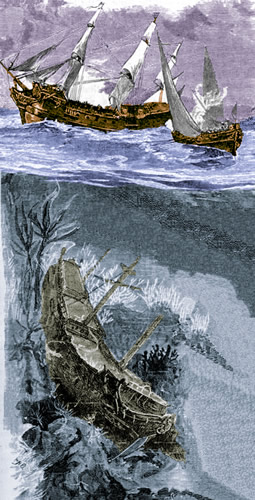
Treasure Salving, From The Sea Its Stirring Story
of Adventure, Peril, & Heroism, Vol 3, By
Frederick
Whymper (1878), Modified & Colored by the Author
The Bahamas continued to attract unsavory elements throughout 1715, particularly after the wreck of eleven of twelve Spanish treasure fleet vessels off the eastern coast of Florida on July 31st. The Spanish sent salvage ships to retrieve the precious metals from their sunken ships, but it was slow work and the treasure attracted the nearby Bahamian pirates and wreckers. Jamaican Governor Archibald Hamilton began issuing privateer commissions to captains in November, including Henry Jennings of the sloop Bersheba and John Wills of the sloop Eagle.10
John Balchen, Captain of HMS Diamond at that time, mentioned that Jennings and an Edward James each fitted out sloops they said they intended to use to attack pirates who were stealing from the Spanish Treasure fleet wrecks (a legal operation). However, "in a shorter time than cou'd be expected, [they] return'd again with a considerable sum of mony, etc., which I cou'd not forbear saying I thought to be the greatest of piracy; and indeed 'tis blam'd by some of the Island [of Jamaica]."11 Upon their return, Balchen noted that at least twenty other sloops were rigged for this same purpose and his men began to desert him, "being all mad to go a wrecking as they term it. For the generality of the Island think they have right to fish upon the wrecks, although the Spaniards have not quitted them."12
By December of 1715, the Council of Trade and Plantations reported that these and other 'privateers' operated out of New Providence, positioning themselves "in the Gulph of Florida, and are so much in the way of all ships that come from the Havana and the Bay of Mexico, that none can pass but what may be met with by your Majesty's ships of war or privateers"13. The council warned that the Bahamas were "in a defenceless condition, and [had] become a refuge for pirates, we are humbly of opinion that for preserving the said Islands to Great Britain, and for incouraging the planters to re-settle on them, the immediate Government thereof be resum'd into the Crown"14. They further requested the appointment of a crown-sanctioned governor to manage the military and civil affairs of the Bahamas.
Three months later,
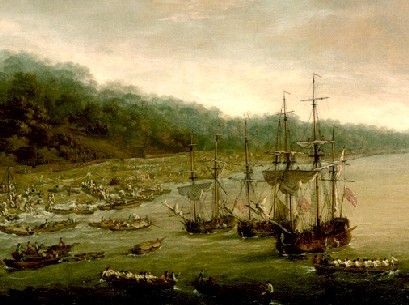
Artist: Dominic Serres the Elder
Men Attacking Caribbean Island From Ships, From The Capture of Havana (18thc)
the Council sent another request, explaining that the Bahamian islands "had been plunder'd four several times during the late war by the enemy, the houses burnt down, the Fort demolish'd, ye guns carry'd off, and that there remain'd not above 12 familys upon all the Islands and those dispersed"15. Some of them fled to Virginia, reporting on their arrival that "a wreck was dayly expected to be found [at New Providence], and also that provisions were scarce"16. It should not be surprising that provisions were hard to come by at this point since the regular settlers who would have taken the time and effort to cultivate food crops, fish or raise animals were being driven away with those who would likely not bother with such tasks. They Council again requested that the king take over the governing of the islands from the Proprietors "for peopling, setling and fortifying the Island of Providence was propos'd; For unless these Islands be secur'd by a fortification, and some regular troops, it is not to be expected a quiet settlement can be made there"17. Effective military governance in the Bahamas at this point would have saved England a lot of future trouble.
The line between 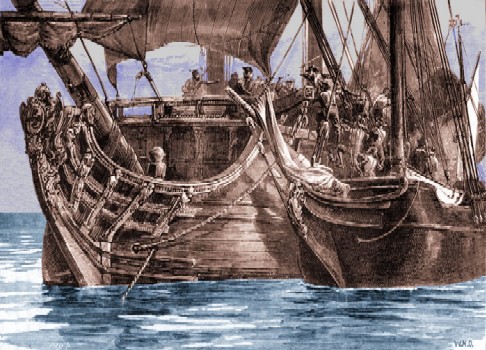
Pirates Attacking, From The Sea Its Stirring Story of Adventure, Peril, & Heroism, Vol 3, By
Frederick
Whymper (1878), Modified & Colored by the Author
respected privateer and pirate in the islands was a thin one. French merchants reported that Jean Escoubet, captain of the l'Aimable Marie was taken off Bahia Honda Key by 'privateers' Jennings captain of the Bersheba, Samuel Liddell of the Cocoa Nut, James Carnegie in the sloop Discovery and Leigh Ashworth sailing the sloop Mary. The Frenchmen actually mentioned five vessels sailing in consort with Jennings, misidentifying one as belonging to a captain 'Leigh'. This was likely John Wills in the Eagle who sailed with Jennings in his raids on the Spanish treasure salvers.18 Jennings sailed to into the harbor of New Providence with this French Prize on April 22, 1716. He shared her cargo which "was worth 250,000 livres tournois. They divided 30,000 piastres amongst themselves and the remainder of the cargo they put aboard the sloop Dauphin, which they sent with the ship to Port Royal, Jamaica."19 The l'Aimable Marie had 32 cannon mounted, making her a fairly substantial vessel for the Caribbean, so Jennings "then went in the said ship to the wrecks where he served as Comodore and guardship."20
Eyewitness Thomas Walker provided a report on the status of the Bahamas to the Council of Trade and
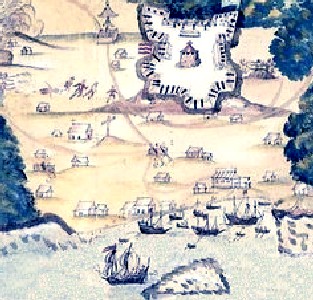
Caribbean Fortress Overlooking a Bay, From Tortuga
Island Sketch (17th c.)
Plantations in 1716 which opined that the islands had become "a recepticall and shelter of pirates and loose fellows and gives ye inhabitants as well as ye trading vessuals from other parts ye liberty and oppertunity of inriching themselves by sideing and dealing with, entertaining and releiveing such villians who from time to time resort there to sell and dispose of their piraticall goods"21 as well as mounting the cannon in Fort Nassau in an attempt to protect their stronghold. Walker noted that he had tried to stop these illegal practices, but this caused the pirates and their local compatriots to try and kill him. "I was thereupon forced with my wife and family to acquitt ye Island to my great expence and damage and ye latter part of June last [1716] arrived safe to this Province [South Carolina] where I remaine upon expence in hopes thatt H.M. will be gratiously pleased to take those Islands under his care and protection, etc."22 He finished explaining that "when I left ye place and seemingly ye pirates were increeseing and groweing so strong under ye resolution of fortifieing and strengthining the place and haveing got to so great a head that consequently will putt ye Crown to some expence and charge to reduce and subdue them, if speedy measures, be not takein"23.
This refrain was repeated over the next year with no action taken by the government. Former Bahamian resident John Vickers testified in July of 1716 that New Providence had been overrun by "about 50 men who have deserted the sloops that were upon the [Spanish] wrecks, and committ great disorders
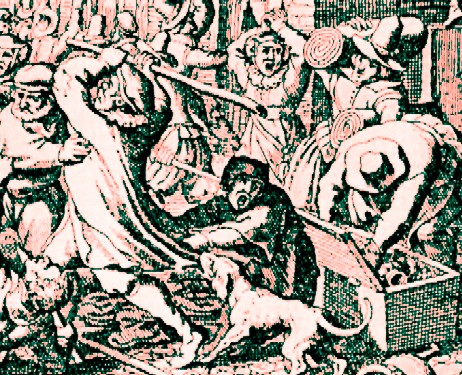
Artist: Matthaus the Elder Merian - A Street Brawl (1628)
in that Island, plundering the inhabitants, burning their houses, and ravishing their wives."24 He said Thomas Barrow was the leader of these men, designating himself "Governor of Providence and will make it a second Madagascar, and expects 5 or 600 men more from Jamaica sloops to join in the settling of Providence, and to make war on the French and Spaniards... Barrow and his crew robb'd a New England brigantine, one Butler master, in the harbour of Providence and took a Bermuda sloop, beat the master and confined him for severall days"25. Vickers notes that the former salvers terrorizing New Providence intended to go pirating once they had procured a ship which would serve their purpose, but the brigantine wasn't sufficient so they let her go. Vickers states that these pirates referred to themselves as 'the Flying Gang'. He notes that they extorted money from the non-pirate residents, giving an example them threatening a passenger on an arriving vessel. The man was "to be whipp'd for not giving them what they demanded, and just upon his coming from thence he payed them 20sh[illings] for which the aforementioned Barrow and one Peter Parr gave him a receipt on the publick account."26. As result of this treatment, "[m]any of the inhabitants of that Island had deserted their habitations for fear of being murdered."27
In February of 1717,
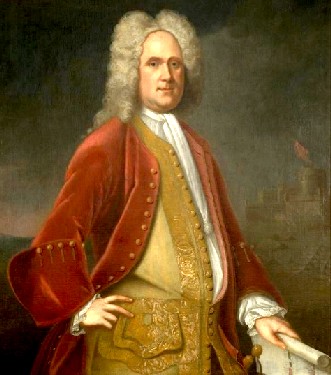
Artist: Charles Bridges
Alexander Spotswood, Lieutenant-Governor of Virginia (1736)
Virginian Lieutenant-Governor Alexander Spotswood warned that "[a] nest of pirates are endeavouring to establish themselves at [New] Providence and by the addition they expect of loose disorderly people from the Bay of Campeachy, Jamaica and other parts, may prove dangerous to British commerce, if not timely suppressed."28 He said that England needed to settle and govern the island to make the island "defencible against sudden attempts by pirates or the Spaniards, who have so often obstructed the settlement thereof, as well knowing that, should the English grow strong there, that island might be reckoned the very key of the Gulph of Florida."29 Three months later he said that "some of the inhabitants of the Island of [New] Providence arrived here, judging it unsafe for them to continue longer in a place which was then become a rendevouze for pirates"30.
The pirate captains making the Bahamas their base continued to change and grow. Privateer Matthew Musson, a captain licensed to take pirates, was shipwrecked on Abaco, Bahamas in March of 1717. There he met the ubiquitous Thomas Walker, from whom he learned that New Providence was now home to "[Benjamin] Horngold, [in] a sloop with 10 guns and about 80 men [the Adventure31]; [Henry] Jennings, [with] a sloop with 10 guns and 100 men [Bersheba]; [Josiah] Burgiss, [having] a sloop with 8 guns and about 80 men; [Daniel?] White, in a small vessell with 30 men and small armes; [Edward] Thatch, [sailing] a sloop 6 gunns and about 70 men. All took and destroyd ships of all nations except Jennings who took no English [ships]"32. (In fact, Jennings did take English ships, it was Hornigold who refused to take them.)
Musson also reported that most of the residents remaining in the Bahamas had left New Providence "gone into other adjacent islands to secure themselves from ye pirates, who frequently plunder
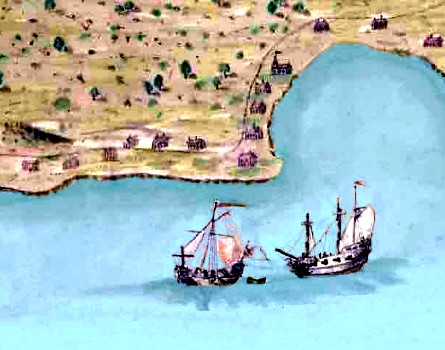
Ships Sailing off a Bay on New Providence, Bahamas, From Exact Draught of
the Island
of New Providence (1st Half of 18th c.)
them. Most of the ships and vessells taken by them they burn and destroy when brought into the harbour and oblidge the menn to take on with them."33 This suggests that the food consumed by the pirates would have been either been taken from such merchant vessels captured or stolen from those who had relocated to other islands. The toll on the local food supply would have been devastating. As Musson explains, "The inhabitants of those Isles are in a miserable condition at present, but were in great hopes that H.M. would be graciously pleas'd to take such measures, which would speedily enable them to return to Providence their former settlement"34.
The merchants of the New World complained of the situation in the Bahamas to the Council of Trade and Plantations, who sent a request to His Majesty that He establish a government and fortification on New Providence, along with "at least one fourth rate or two fifth rate men of war, [which] were absolutely necessary to suppress those pirates and protect the Trade. They further proposed that H.M. be graciously pleased to pardon the said pirates provided they come in and surrender by a certain time to be limited."35 So it was to finally happen.
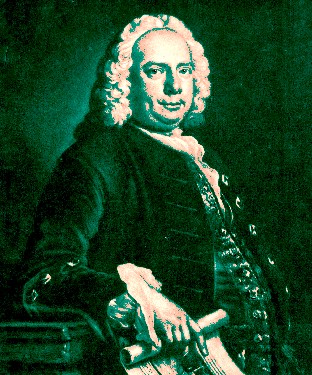
Artist: Richard Houston
Samuel Buck, From Buck's Antiquities, The British Museum (1774)
Working from an aborted plan he had for reclaiming Madagascar from the pirates there, Woodes Rogers began promoting an effort to resolve the chaos at New Providence by doing these very things. Rogers had established an alliance with English merchant Samuel Buck, an agent of the Lords Proprietors for the Bahamas with whom he formed 'The Copartners for Carrying on a Trade & Settling the Bahama Islands'.36
The Council of Trade and Plantations expressed their approval of Rogers and his plan in a letter to the King on July 26, 1717, noting "that what Capt. Rogers has proposed, will not only be of great advantage to the publick, but also to the Lords Proprietors in particular, he offering to proceed to Providence etc."37 In response to their letter, Secretary of State for the Southern Department Joseph Addison wrote to the Council of Trade and Plantations on September 3 that the King was "very well satisfied with your Lo[rdshi]ps. Representation of the importance of those Islands to the British Trade and Navigation in those parts, as also with the character which is given of the said Captain Rogers by the most considerable merchants of London and Bristol, as a person every way qualified for such an undertaking"38. With that, the king appointed Rogers to be Governor of the islands. The Lords Proprietors were convinced to surrender their rights to the Bahamas for twenty-one years to Rogers, something formally acknowledged in October. The document which noted that this also relinquished the rights to "the fishing of all sorts of fish whales sturgeon and all other royall fishes in the seas bays islands and rivers ... and the royall fish and others therein taken together with the royaltye of the sea upon the coast within the limitts aforesaid"39. They expressed a desire to have the islands resettled and fishing would have been a needed food source.
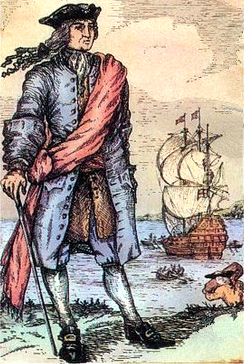
Woodes Rogers, From a Bahamian
Commemorative Stamp (1987)
Rogers trip underwent a variety of changes before it actually began. In July of 1717 , Rogers said that his group had a ship of "400 tuns burthen and will carry 34 guns: wee propose to man her wth. 150 seamen and artificers [craftsmen] at our own expence, with such other small vessells as shall be necessary to carry all things fitt for a new settlemt., and transport such souldiers and stores as the Crown shall be induced to send etc."40 By September, they were planning to bring 500 Germans who had immigrated to England (called Palatines) with them, along with "Provisions, clothing, bedding, passages and medicine"41. Rogers also requested that the 'independent company' of soldiers intended to be established at the island under his command be 'placed upon the establishment', that is, paid for by the government, and he offered "to victual them at 6d. per head per diem for the first year with provisions from the Plantations, etc. Estimate of charge to the Crown."42 By the time Rogers was ready to sail, it was April of 1718. The 500 Palatines had dwindled to about a dozen43 and Rogers was tasked with paying for victualling as many soldiers as he could recruit for his independent company.44 This limited the amount of crop cultivation that these new settlers would be able to undertake. Rogers' partner Samuel Buck wrote that they had "fitted out four shipps with propper cargoes... with clothes and tools for cutting wood and clearing the land, and gave three years creditt for the same to such planters as should come to settle. We also hired and sent severall handicrafts with proper tools for clearing the lands and building of houses"45.
While Rogers was preparing for his voyage, the government issued ' A PROCLAMATION For the more effectual Reducing and Suppressing of PIRATES and PRIVATEERS in AMERICA' on September 5, 1717 which was to remain in effect for one year. This would support Rogers' arrival in Nassau and was intended in part to provide him with people to help settle the Bahamas. Captain Benjamin Bennet, then Lieutenant-Governor of the Barbados, sent a sloop to New Providence on December 19th informing the residents there of the proclamation. They received the news "with great joy, there being near 300 of them, and most agreed that in a little time they would come and surrender themselves to me, and added they were satisfied that others their consorts that were out a cruiseing, when they heard of the proclamation, would doe the like"46. Bennett reported in February of 1718 that Jennings and eight others sailed to the Bermudas to receive the pardon.
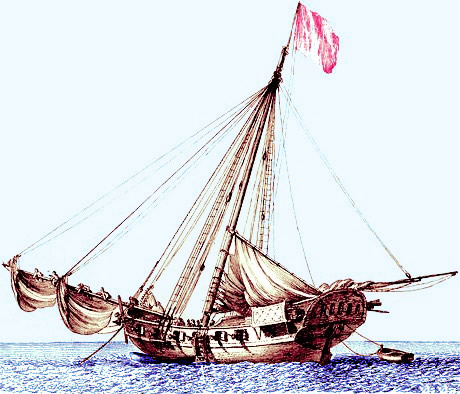
Artist: Pierre Ozanne
Bermuda Sloop From Melanges de Vaisseaux, de Barques et de Bateaux, (c. 1780)
By late March, Bennett said that Captain Vincent Pearce of HMS Phoenix had sailed to New Providence in early March who "by his prudent managemt. and conduct had occasioned a great m[an]y of the pirates to surrender upon which he gives them certificates of their soe doeing, they all tell me that there is not above 200 men (I mean pirates) att Providence and Harbour Island who are all very quiet and respectful to Capt. Pierce, and therefore hope will come in etc."47
Bennett's opinion of the proclamations' effect on the pirates had somewhat soured by May. He noted that ships coming from the Bermudas sailed by "the Bahama Islands or Turks Islands for a load of salt, which many of the pirates well know, and consequently when they want a sloop or provision can tell where to meet Bermudeans"48. This underscores the necessity of the pirates to take ships to provision themselves, suggesting a lack of food in the Bahamas where they resorted when not on the account. Bennett went on to list the pirates at sea including Edward Teach and Stede Bonnet, Edward/Christopher Condent, Charles Vane and several unnamed French pirates, among others. He warned that if the pirates "should joyn together they will be much superior to what force we can make to oppose them… for without employing our navigation we must starve, this country not produceing sufficient for a quarter part of the people that lives in it"49.
In June, South Carolina Governor Robert Johnson sent a letter to the Council of Trade and Plantations casting doubt on the effectiveness of the proclamation. He explained that "some few indead surrender and take a certificate of there so doing and then severall of them return to the sport again"50. Despite Pearce's presence in Nassau, Johnson learned that "severall sloopes have fitted out a pyrating from thence dureing her being there and I am credibly inform 'd there are above 20 sail now in these seas so [tha]t. unless ships be sent to cruse upon them, all the trade of these American parts will be stopt, for hardly a ship goes to sea but falls into there hands."51
Rogers arrived off New Providence on July 25, 1718. He kept his vessel Delicia, the Willing Mind along with HMS Milford and HMS Shark three miles off the coast of the island.52 The third warship, HMS Rose, sailed into the harbor. Rogers' report to the Council of Trade and Plantations stated:
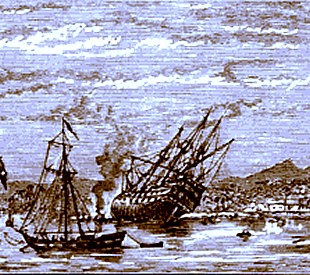
From The Sea - Its Stirring Story of Adventure, Peril, & Heroism.
Vol 3, By Frederick Whymper, (1878)
I met with little opposition in coming in, but found a French ship.(that was taken by the pirates of 22 guns) burning in the harbour, which we were told was set on fire to drive out H.M.S. the Rose who got in too eagerly the evening before me, and cut her cables and run out in the night for fear of being burnt, by one Charles Vane who command'd the pirates and at ours and H.M.S. the Milford's near approach the next morning they finding it impossible to escape us, he with about 90 men fled away in a sloop wearing the black flag, and fir'd guns of defiance when they perceiv'd their sloop out sayl'd the two that I sent to chase them hence.53
Rogers went on to say that he was met by "about 300 of the people found here, who received me under armes and readily surrendered, shewing then many tokens of joy for the re-introduction of Governmt."54
In setting up a government for the Bahamas, Rogers' wanted to find residents who were the least supportive of the pirates to put on a Bahamian Council. As constructed, it contained six men he had brought with him to settle the island and six of these 'honest' local residents. Although he didn't initially choose Thomas Walker for this council, two of the men he did choose died within a few months of arrival, resulting in the addition of Walker to replace one of them. Rogers explained that the six locals were "men of the best morals amongst the people, and I believe are capeable to advise us of anything relating to lands on the Bahamas, till more fit persons arrive to settle here."55
Rogers had difficulty mobilizing people to do the work required to defend the island and make it more sustainable. He and many of the people he brought became ill during their first few months (likely due to water-borne germs and tropical illnesses such as typhoid, malaria and possibly yellow fever), a common problem for new arrivals. It was believed that once a government had been established
on the island, people from neighboring islands would come 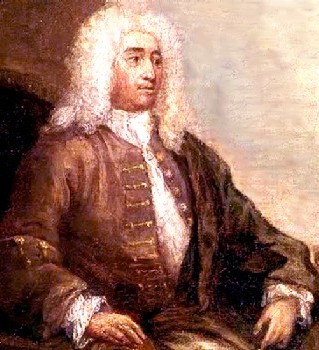
Artist: William Hogarth - Woodes Rogers (1729)
to establish plantations and make the Bahamas more self-sufficient. However, a report sent to English Secretary of State James Craggs the Younger 'from a person on whose intelligence I very much rely' (possibly Thomas Walker) based on observations from 1718 and 1719 said this never occurred. The report noted that "most of the Colony(s) round us gave us great encouragement that people of substance would leave them and come and settle here, but the frequent alarms of the Spaniards arming against us etc., and the pyrats robbing all round us and threatning to re-enter the place, with H. M. ships not coming near us, kept all our neighbours from venturing to settle here"56.
The Bahamian pirates who had accepted the pardon didn't prove to be particularly helpful either. While they may have surrendered readily enough, they weren't inclined to help Rogers in his efforts to rebuild the fortifications and cultivate the island. Rogers reported in October of 1718, "half of those who have been pirates left, for they soon became weary of living under restraint and are either gone to several parts of North America, or engaged themselves on services at sea, wch. I was willing to promote, for they are not the people I ought to think will make any land improvements, and I wish they may be faithfull at sea.”57
Fortification was crucial to creating an environment that would allow the effective establishment of plantations in the islands. Rogers said that because Fort Nassau was a ruin with a cracked foundation, he intended to build two other forts to protect Nassau Harbor if England would provide the funds. He also advised that there was plenty of good wood, stone and lime (used to make mortar), "but at present the excessive laziness of the people and sickly season has been the only cause, I have not put the place by this time in a better posture of defence."58 No funds were allocated for this, however. As those he brought to the island began to recover, Rogers' report attitude towards fortification improved and he mentioned that "our fort will be soon in a tollerable posture of defence, and the guardship is well provided"57. He mentioned that Hornigold's help and presence aided his efforts significantly.
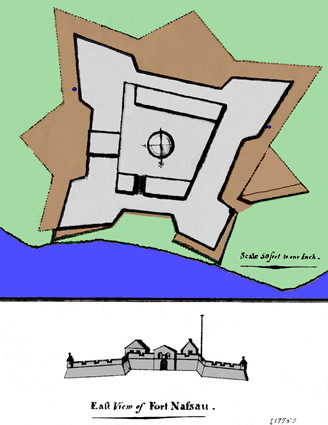
The Plan of Fort Nassau, Bahamas, From the Strachey Paper
University of Michigan (1775)
Efforts at rebuilding the fort were accelerated when Rogers learned that Admiral Sir George Byng had fought the Spanish navy on August 11, 1718 off of Cape Passaro, Italy. War appeared to be in the offing and the New Providence citizens, after "much application and expence of provisions and liquors having [been] supplied whilst at work extravagantly with both, the fort is now made tenible... The people did for 14 days work vigorously, seldom less than 200 men a day, but nothing but their innate thirst of revenge on the Spaniard could prompt them to such zeal"60.
The need to finish the defences must have weighed heavily on Rogers; two of the warships who had accompanied him to New Providence - HMS Milford and HMS Shark - left to return to England on August 16, 1718. The captain of the HMS Rose, Thomas Whitney, had planned to take his 20 gun sixth rate back to England as well. By pleading with Peter Chamberlain, Commodore of the small fleet, Rogers "wth. some difficulty procured his order to Capt. Whitney [20 gun Rose] to stay three weeks longer in which time I was in hopes my men and the fortification would be in a better state"61. Whitney remained until September the 14th, a week longer than he had promised and then left, despite Rogers' request that he remain longer to help defend the islands.
The number of people resident at New Providence as well as those able to defend her varied substantially between different accounts. Recall that Rogers said he was greeted by about 300 pirates when he arrived in July. Writing about September of 1718, he said he could "muster in armes of our own people belonging to the Independant Company, 112; of passengers and new inhabitants that I can rely on, 30. And at our last muster of ye merooners and the inhabitants we have at home to appear in armes, 152."62 This made for a total of 294 men Rogers could expect to defend the island, with roughly half of the original 300 pirates who had met him on arrival. By 1719, Craggs' informant wrote that Nassau had "a good fort and above 50 guns mounted, so that we may depend, if we can muster 250 men on withstanding any enemy that may atacque us, yet the poverty of the place and

Cartographer: Thomas Cocklyn
Harbor Island and Eleuthera With Fort on Northern End of HI (1718)
want of trade makes the inhabitants instead of encreasing as we expected, leave in almost every vessel that returns hence to the Colonys arround us, and from 400 men we are already decreased to less then two"63. While the 250 estimate is less than Roger's own, his 400 man estimate is considerably higher.
Rogers also reported on the inhabitants of the two other nearby Bahamian islands. He said Eleuthera had "about 50 familys and 70 men formed into a Militia Company". Harbor Island (off Eleuthera) contained "about 60 familys, and 80 men wch. are also in another Company of Militia they have fortified themselves and secured the harbour wch. is very narrow at the enterance but a ship of 18 foot water may go in and ride very securely". He added that he had given powder and bullets to residents of these islands, "for they have two small forts, one of eight six-pounders and the other of four nine-pounders that commands the entrance and harbour."64 One of these was a 'small battery' originally built by Thomas Walker when he was living on Harbor Island in 1710 into which he placed four cannon and some swivel guns.65 This battery was still present in 1717, when the pirates overran Harbor Island, placing 50 men in it.66 About the second fort, which Rogers report suggests was located on Eleuthera, no information was found.
Rogers' primary reason for wanting to have a good system of defense was initially caused by the threat of pirate Charles Vane, who had promised to retake the Bahamas when he sailed off in 1718. In late August, 1718, Rogers said he had received a report "that three vessels supposed to be Vaine and his prizes
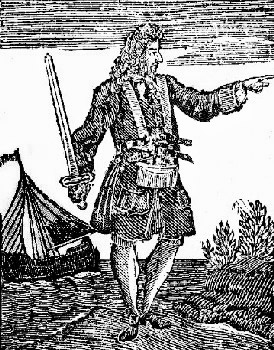
Pirate Charles Vane
from The General History
of the Pirates (1724)
were at Green Turtle Key near Abacoa and since I had no strenght to do better, I got a sloop fitted under the command of Capt. Hornygold to send and view them and bring me an accot. what they were"67. Hornigold returned three weeks later with Nicholas Woodall's sloop Wolf in tow, which Rogers noted had been allowed to go out to capture turtle. Bahamians frequently caught turtle to sell or trade with other islands. Rogers could do nothing with the knowledge of Vane's location because, as he explained, Whitney had already left in the Rose and he had no warship to challenge the pirate, who now had two ships and a brigantine. However, by late October, Rogers felt that the fort would soon be able to defend the island from Vane.68
Setbacks followed this exuberance, however. Rogers continued to lose the allegiance of his reformed pirate citizens. Samuel Buck reported that the former pirates "are neither honest nor industrious, working does not agree with them, and they may want necessarys"69. Several men attempted to return to pyracy by overtaking the captains of three sloops - the Mary, the Lancaster and Batchelor's Adventure - which Rogers had sent to Cuba on a trading mission in late October of 1718. Phineas Bunce and Denis McCarty led the mutinies.70 A Spanish ship heading to attack Eleuthera attacked the pirates in these captured ships upon encountering them, trapping them on Green Turtle Cay. Hornigold and Cockram were sent to retrieve them, "apprehending them to the number of 13, three whereof dyed of their wounds", with all but one of the remaining pirates being hung at New Providence.71 To make matters worse, Vane reportedly plundered Eleuthera around this time, stealing provisions from the inhabitants.72
Roger's optimism over the New Providence's defensive position did not last either. By May of 1719, concerns about the Spanish worried him. He told Secretary Craggs "I may expect to be soon attacked and am preparing to make the best defence I can. I doubt I shall scarce be able to gett together above 300 men, were we but 200 more being well prepar'd I should not be under any great concern for this Spanish Expedition."73

Nassau Fort and Surrounding Town, From Exact Draught of the Island of
New Providence
(1st Half of 18th c.)
In December of 1720, Rogers was sick, he had had no official communication for quite some time, the money he had made from his privateering voyage and the sales of his book had been spent on the Bahamian project. Dejected, he sailed for Charleston, Carolina.74 At the end of his first term of office as governor of the Bahamas (for he served a second beginning in August of 1729), he could at least claim that he had largely eliminated the pirate threat, something which contributed significantly to the end of the golden age of piracy.
George Phenney was declared governor of the Bahamas in June of 1721 in Roger's place, arriving in the Fall of that year.75 The fort had either not been finished or had deteriorated since Rogers' repairs because in November, Phenney and the Bahamian Council reported "that the Fort we now have is not capable to mount the guns, and we want power to enact laws to raise funds to rebuild the Fort, and do other publick works absolutely necessary for the general good and support of this Colony."76 In a letter to the Council of Trade and Plantations sent in December, Phenney explained, "The Fort has only two thin stone walls and the interspace fill'd with earth, the bastions are all deformed and falling, the parapets being of plank are most part decay'd, so that it is thought necessary here to have the whole rebuilt"77.
Phenney reported on the population of the islands in February of 1722, which historians Michael Craton and Gail Saunders suggest "was almost certainly
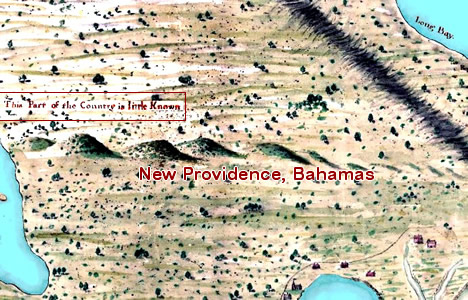
Mid-Eastern Interior of New Providence, Bahamas, From Exact Draught of the Island of
New Providence
(1st Half of 18th c.)
the first accurate computation of the Bahamian population"78, probably because everyone else seems to have been estimating (or possibly guessing). Phenney listed "470 Whites on [New] Providence, of which 170 may be accounted able to bear arms, 233 Blacks, whereof 90 able to bear arms. On Harbour Island there are 124 whites, of which 28 able to bear arms, and about 5 negroes. On Ilathera [Eleuthera] there are 150 whites, of which 50 fit to bear arms. 34 negroes whereof 23 able to bear arms. On Cat Island there are about 12 Whites, and 2 or 3 able negroes."77 He also noted that there weren't many plantations in the Bahamas, a fact he blamed on "the want of an Assembly, by the concurrence of which only we can expect the power to settle the claims of persons to the great waste of lands which now lyes barren, and cant yet escheat them."80 Three months later, Phenney decided "to open a way into the center of [New Providence] Island where I don't doubt finding good land for planting. Our present sett of people being mostly seafaring men have not any great notions that way."81 Most, if not all, of the settlements of New Providence were located near the shore. A note on a map New Providence Island from around around this period states 'This Part of the Country is little Known'.
The removal of the pirates led to a period of peace for the Bahamian residents, which should have allowed them to cultivate the land if it were reasonable to do so. Phenney reported near the end of 1723,
The remaining Palatines are now by my assistance in a very flourishing condition and get mony by supplying the markets here with several necessarys. They are a very industrious people and I could wish for a great many more of them, the land here being capable of cultivation, and as your Lordship will observe by the papers enclos'd what this country' produces, so the scituation is certainly most proper for carrying on a profitable trade80
While this may have been true, much of the land in the Bahamas was never particularly good for most crops, something the long-time residents likely already understood.
1 Manuel Shonhorn, Introduction, A General History of the Pyrates, 1999, p. xxi-xxii; 2,3,4 Calendar of State Papers Colonial (CSPC), Vol. 27, 1712-1714, Item 651; 5 Person Residing at Jamaica, The state of the island of Jamaica, 1726, p. 8; 6 CSPC, Vol. 28, 1714-1715, Item 276; 7,8,9 CSPC, Vol. 28, 1716 - July, 1717, Item 240.i; 10 CSPC, Vol. 29, 1716 - July, 1717, Item 258.v; 11,12 CSPC, Vol. 29, Item 158.iv; 13,14 CSPC, Vol. 28, Item 710.i; 15 CSPC, Vol. 29, Item 108; 16 CSPC, Vol. 30, Aug, 1717 - 1718, Item 10.ii; 17 CSPC, Vol. 29, Item 108; 18 CSPC, Vol. 29, Items 240.i. & 357 (d); 19 CSPC, Vol. 30, Item 591; 20 CSPC, Vol. 28, Item 240.i; 21,22,23 CSPC, Vol. 29, Item 328; 24,25,26,27 CSPC, Vol. 29, Item 240.i; 28,29 CSPC, Vol. 29, Item 240; 30 CSPC, Vol. 29, Item 595.v; 31 "Hornigold, Benjamin (c.1657?-1710)", Dictionary of Pyrate Biography, 1713-1720, Baylus C. Brooks, ed., 2020. p.219; 32 CSPC, Vol. 29, Item 635; 33 CSPC, Vol. 29, Item 596; 34,35 CSPC, Vol. 29, Item 635; 36 Colin Woodard, Republic of Pirates, 2015, p. 166; 37 CSPC, Vol. 29, Item 671.i; 38 CSPC, Vol. 30, Item 64; 39 CSPC, Vol. 30, Item 176; 40 CSPC, Vol. 29, Item 657.i; 41 CSPC, Vol. 30, Item 76; 42 CSPC, Vol. 30, Item 287; 43 Michael Craton and Gail Saunders, Islanders in the Stream, 1992, p. 116; 44 Sandra Riley, Homeward Bound - A History of the Bahama Islands to 1850, 2015, p. 68; 45 CSPC, vol. 31, 1719 – Feb 1720, Item 545; 46 CSPC, Vol. 30, Item 345; 47 CSPC, Vol. 30, Item 474; 48,49 CSPC, Vol. 30, Item 551; 50,51 CSPC, Vol. 30, Item 556; 52 Woodard, p. 162 & Riley, p. 69; 53,54,55 CSPC, Vol. 30, Item 737; 56 CSPC, Vol. 31, 1719 - 1720, Item 525.ii; 57,58,59 CSPC, Vol. 30, Item 737; 60 CSPC, Vol. 30, Item 807; 61 CSPC, Vol. 30, Item 737; 62 CSPC, Vol. 30, Item 737; 63 CSPC, Item 525.ii; 64 CSPC, Vol. 30, Item 737; 65 CSPC, Vol. 25, 1710-1711, Item 421.i; 66 CSPC, Vol. 29, Item 596; 67,68CSPC, Vol. 30, Item 737; 69 CSPC, vol. 31, Item 545; 70 Daniel Defoe (Captain Charles Johnson), A General History of the Pyrates, Manuel Schonhorn, ed., 1999, p. 628-9 & CSPC, Vol. 30, Item 737; 71 Defoe (Charles Johnson), p. 640 & CSPC, Vol. 30, Item 807; 72 Defoe (Charles Johnson), p. 620; 73 CSPC, Vol. 31, Item 205; 74 Riley, p. 77; 75 CSPC, Vol. 32, March 1720 - 1721, Items 524 & 726; 76 CSPC, Vol. 32, Item 726; 77 CSPC, Vol. 32, Item 758; 78 Michael Craton and Gail Saunders, Islanders in the Stream, 1992, p. 119; 79,80 CSPC, Vol. 33, 1722 - 1723, Item 45; 81 CSPC, Vol. 33, 1722 - 1723, Item 455; 82 CSPC, Vol. 33, 1722 - 1723, Item 803

